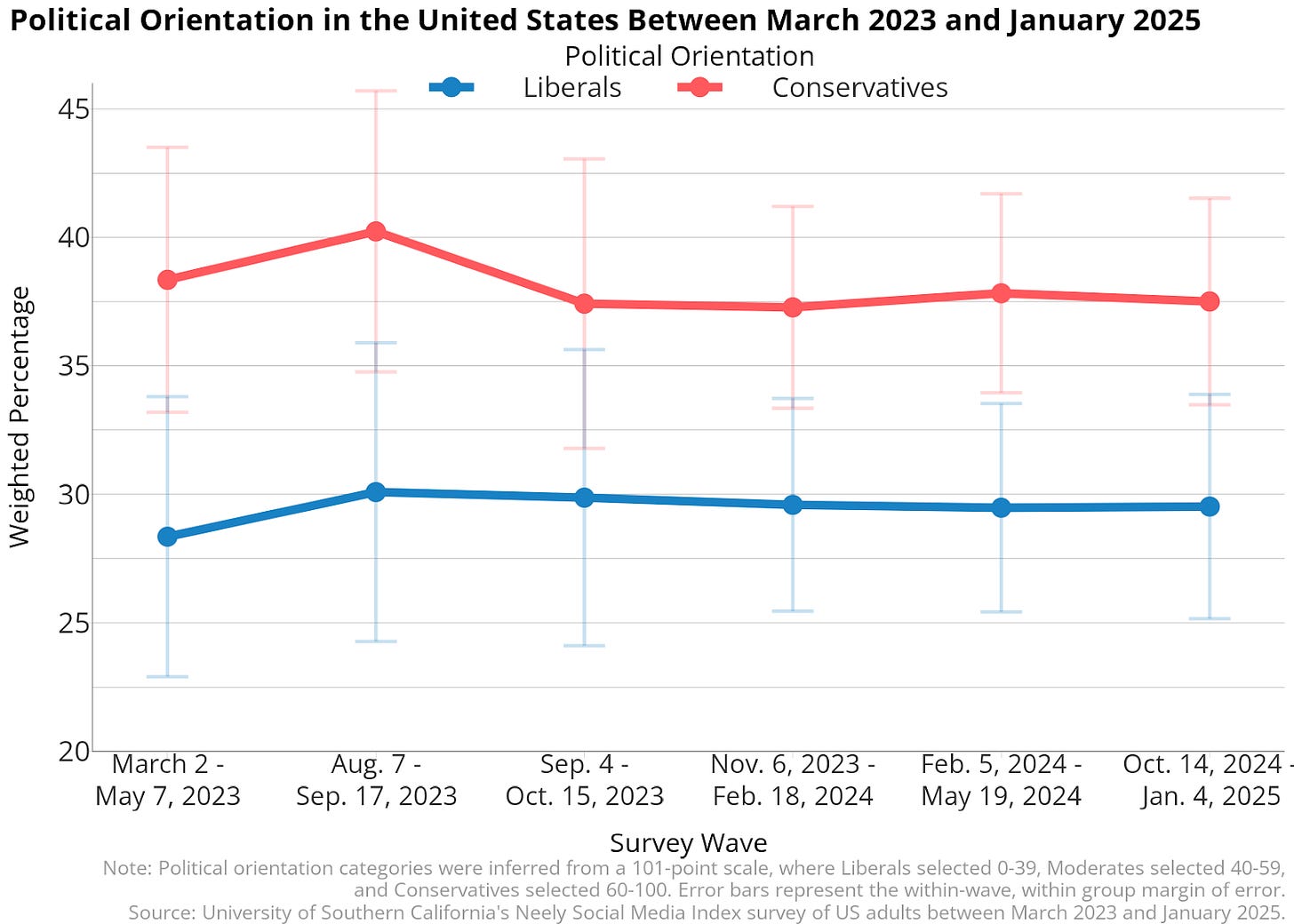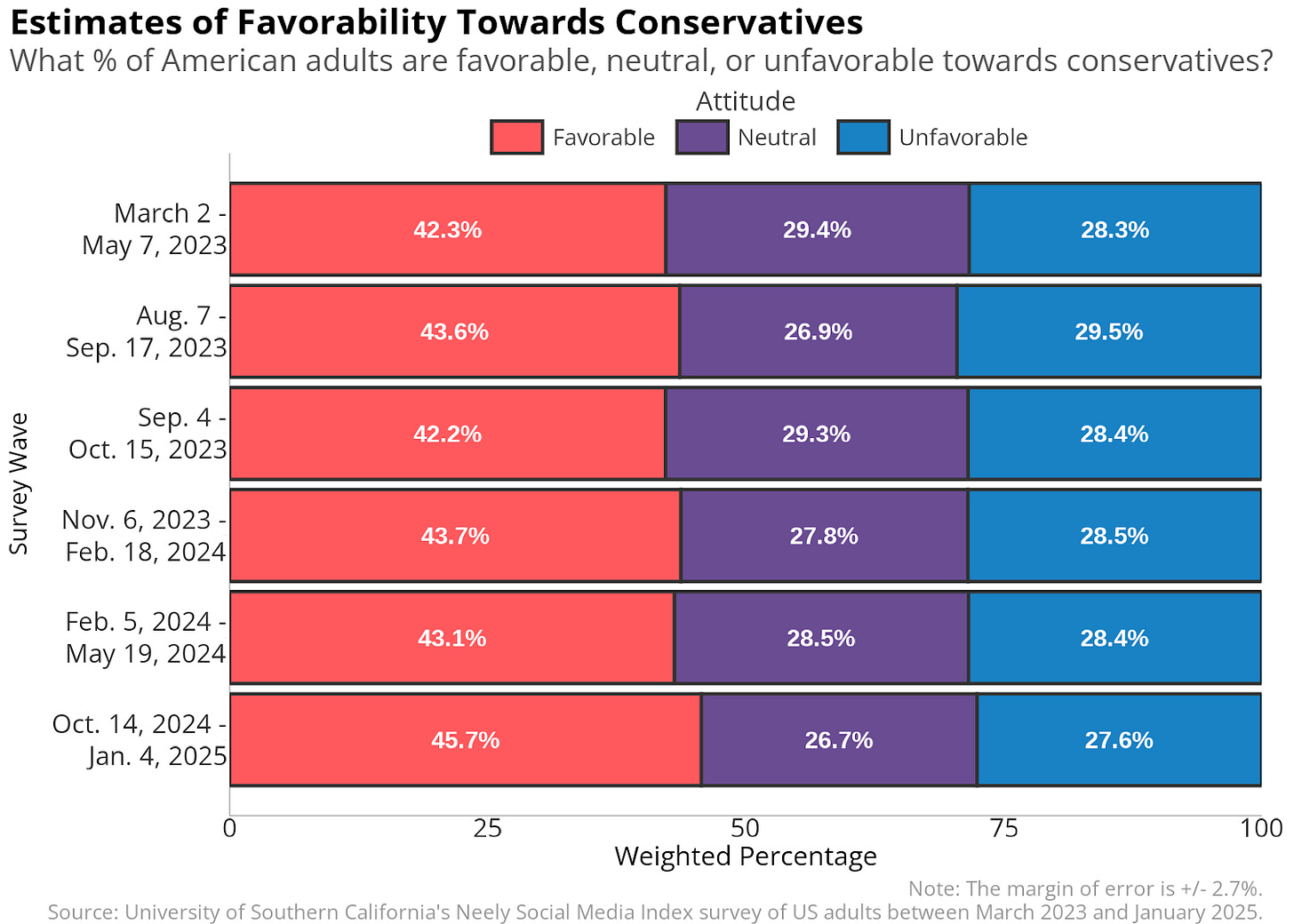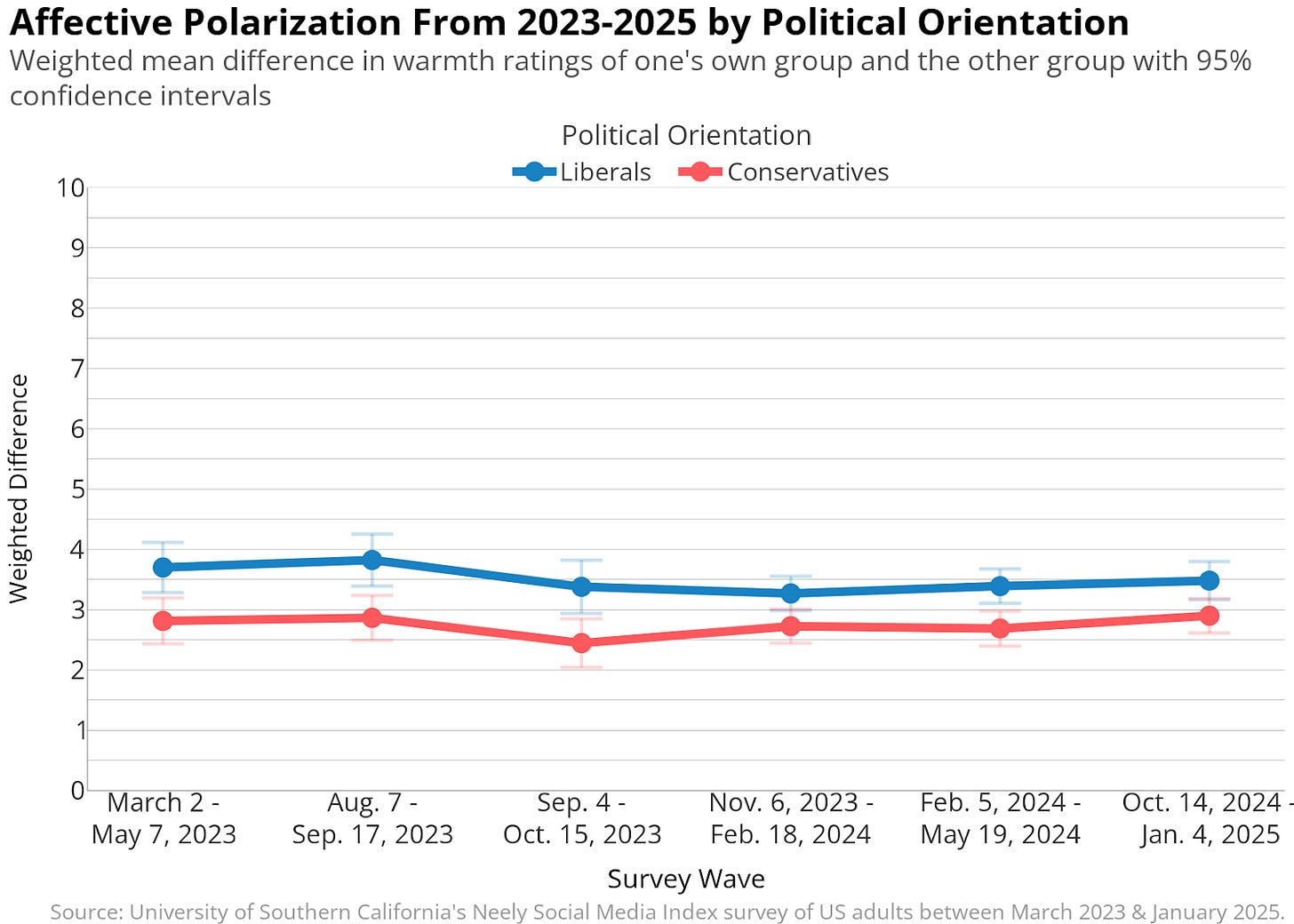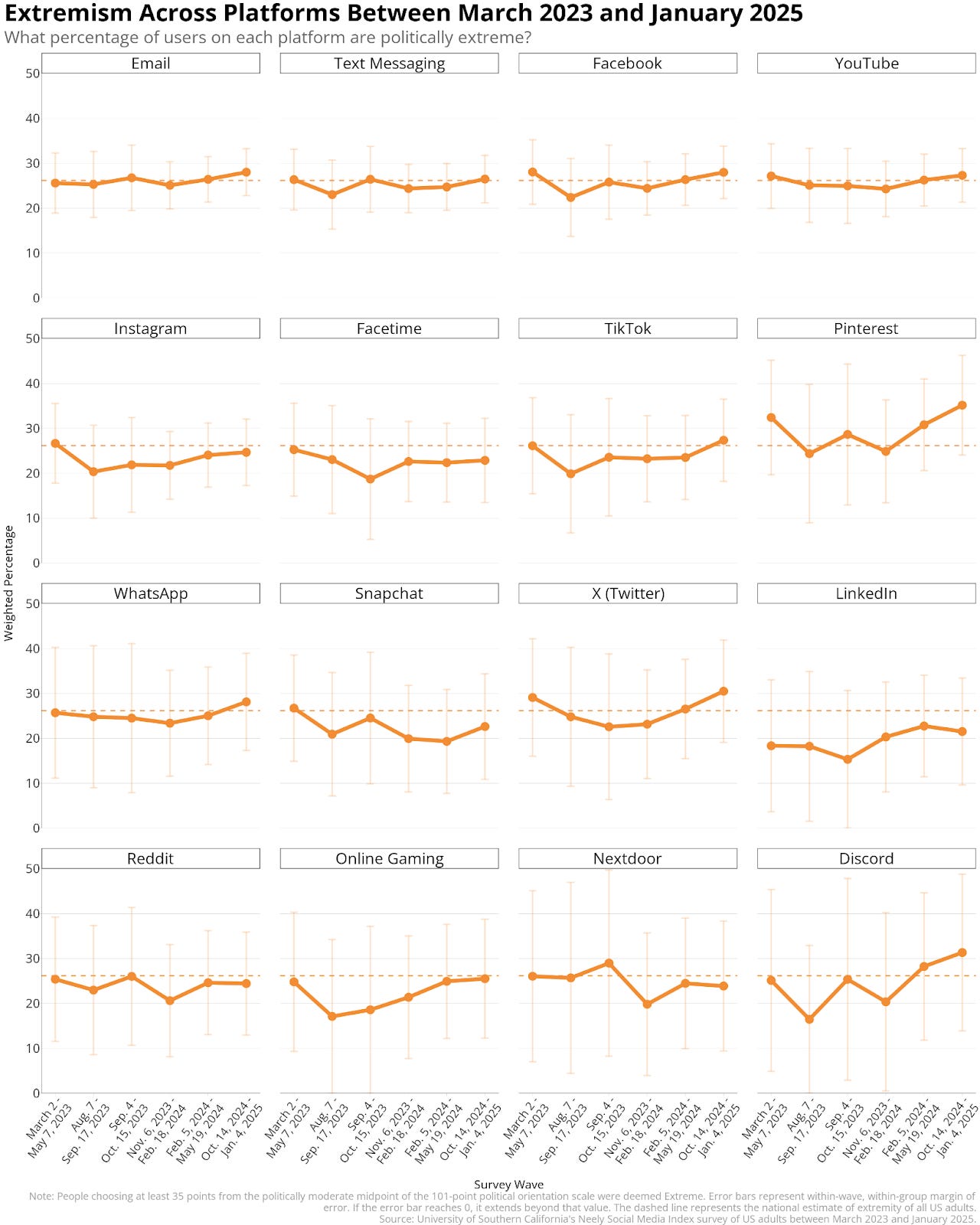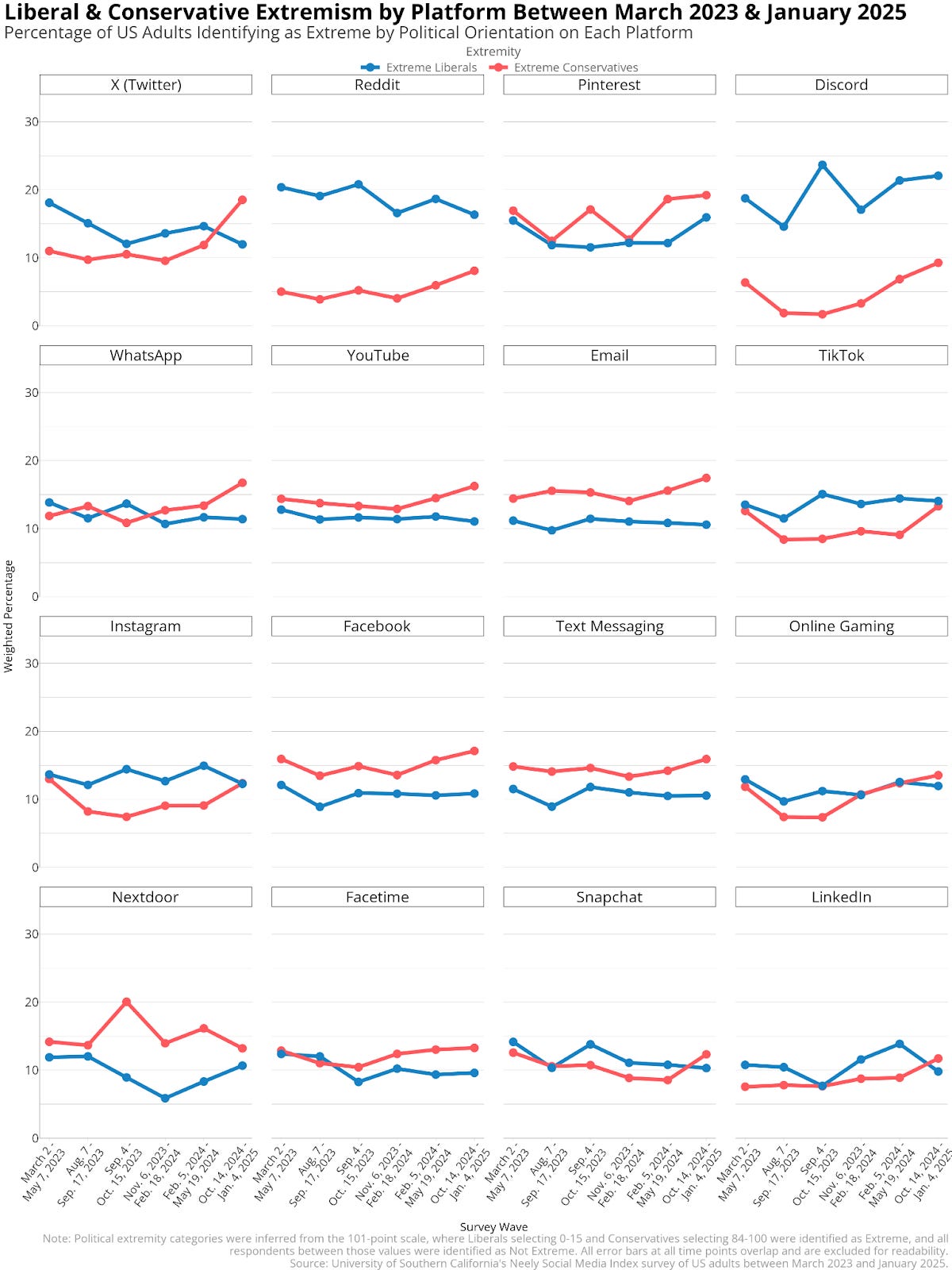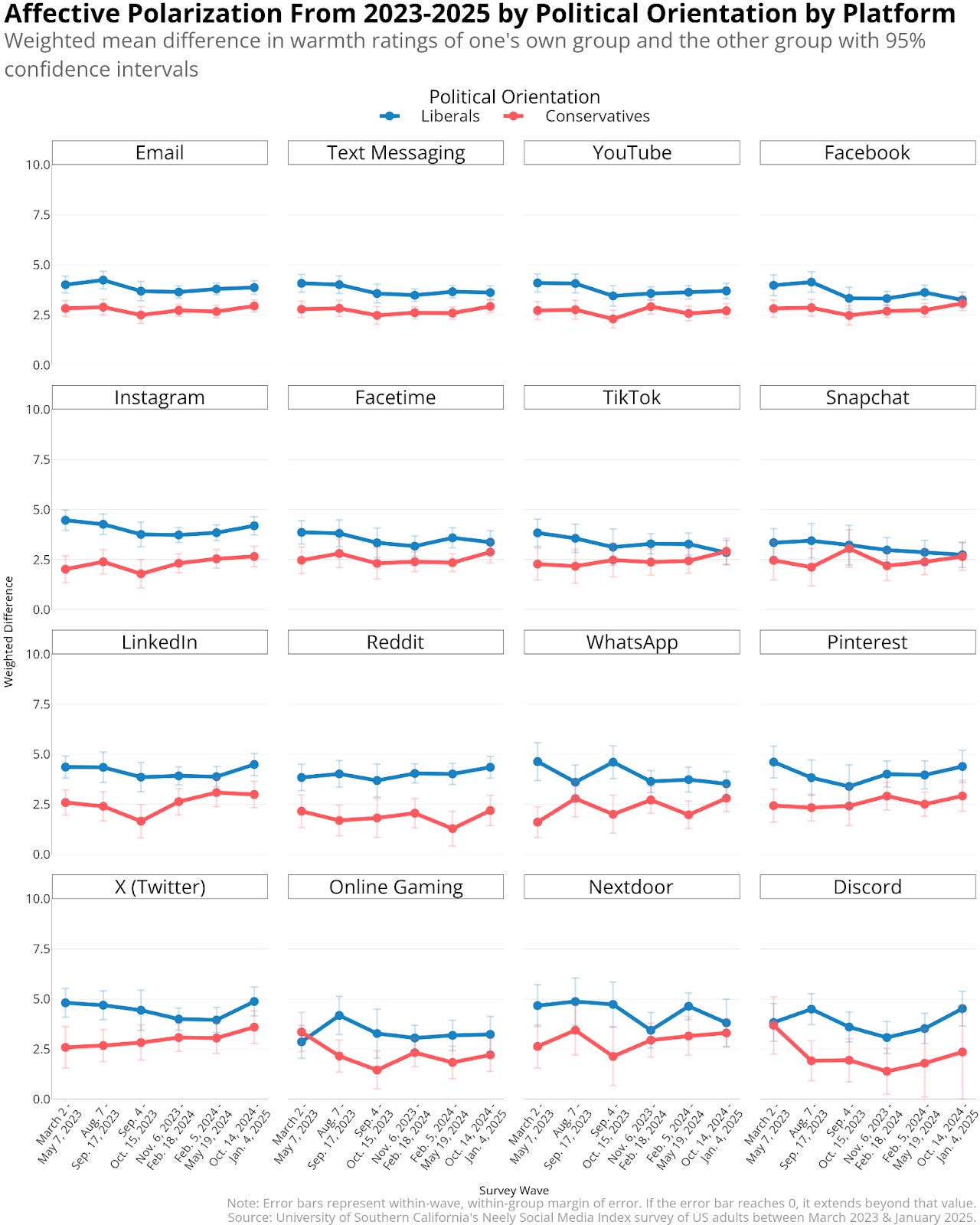Social Media and Politics from 2023-2025
I examine the political identities, extremity, and polarization of US adults across platforms over a 2-year national survey.
This is a post where Senior Advisor Matt Motyl analyzes and summarizes data from the University of Southern California Marshall School’s Neely Center Ethics and Technology Indices. The project builds on industry precedent to create independent verifiable, cross-platform metrics of user experiences, which we leverage in discussions with companies, the press, and policy makers. You can read more about the methodology of the project here and find a full list of analyses here.
Early on, social media’s role in politics was mostly limited to individual users opining about their attitudes, and occasionally coordinating and mobilizing citizens to participate in campaigns, elections, and even revolutions (e.g., the Arab Spring). Over time, though, parties and even countries began using social media to launch coordinated influence operations to interfere in rival countries’ elections. Further, politicians began using social media as a tool to promote their own voices (e.g., Donald Trump posted 25,000 tweets during his 2017-2021 presidential term). Many have implicated social media in contributing to the rise of polarization and political violence, to unfairly silencing some political speech (while promoting others’), and for making it possible for people of different political persuasions to segregate onto platforms that are more congenial to their beliefs. Suffice to say, social media plays no small part in people’s political lives.
For nearly 2 years, we at the University of Southern California’s Neely Center for Ethical Leadership and Decision Making have conducted a longitudinal survey of a nationally representative sample of US adults regarding their usage of and experiences on social media (along with other social technologies, like email and text messaging). As part of this survey, we’ve also asked US adults some questions about their political inclinations, how they feel about people with political views different from their own, and who they preferred to win the 2024 Presidential Election. We analyzed some of these variables after the very first wave of our survey back in the spring of 2023.
Following 5 additional survey waves culminating 22 months after the initial survey wave, including before, during, and after the 2024 Presidential Election, we are able to examine political changes over time. In this report, we ask 3 main questions:
How have Americans’ politics changed in the past few years?
Have platforms shifted to be more liberal or conservative? More or less extreme?
Which platforms’ and services’ users are most and least polarized? Which platforms’ and services’ users are most tolerant and intolerant of politically similar and dissimilar others?
Americans’ Political Leanings from March 2023 - January 2025
To understand the politics of different social media platforms, we first need to understand the politics of Americans. Historically, especially since 1991, more Americans identify with the Democratic Party than with the Republican Party. The current sample reflects this pattern, whereby 29.2% of Americans are registered Democrats and 26.9% of Americans are registered Republicans. Yet, with less than 1% of US adults affiliating with a smaller party, this leaves just over 40% of registered voters unaffiliated with any party. These unaffiliated voters, however, tend to vote as if they were partisans, consistently voting for one party over the other. To address this, political scientists developed a follow-up question that they ask of their respondents who report being Independent to determine whether they tend to prefer one party over the other.
In our longitudinal survey, we only asked people about their party identification in the first 3 waves during 2023, and used the standard follow-up question for those not identifying with any party. In the graph below, we replicate the oft-observed tendency for slightly more Americans to identify with or lean towards the Democratic Party than the Republican Party.1
Party affiliation and leaning increasingly shed light on how liberal, moderate, or conservative Americans may be, but there is substantial variability in the political orientations of people in the major parties. To capture people’s political orientations more directly, political scientists ask people where they place themselves on a continuous spectrum from “Very Liberal” to “Very Conservative.” This approach takes an extraordinarily complex network of beliefs and simplifies them into a single dimension, but admittedly brushes over some important differences. Nonetheless, this is predictive of party affiliation, attitudes, and voting. Historically, more people identify as conservative than liberal, but the plurality of people tend to be moderate. This pattern holds true in the current sample, too, and persists across all 6 waves of the survey.
Despite a contentious election year that included two assassination attempts and the incumbent dropping out of the race, party identification and political orientation have held relatively constant over the past two years. Given the heightened polarization in the United States in recent decades and the intense campaign year, we might also expect to see growing extremity and polarization between 2023 and 2025.
Extremism
One way to assess extremism is by looking at how far from the midpoint of the 101-point political orientation scale, and estimating the number of people within 15 points of either the “Extremely Liberal” or “Extremely Conservative” scale anchors at each time point.2 In the plot below, I show the percentage of US adults who are at the extreme ends of this scale stays between 24 and 29% at each time point. Therefore, by this measure, it appears that overall extremism did not change between 2023 and the beginning of 2025. This is not to say extremism has not changed for some subgroups or in some places, just that at the highest level of abstraction, extremism has held constant.
It is also possible that political extremity is more likely among people with particular political leanings. In the next plot, I examine the composition of those identified as politically extreme in the previous plot. Not surprisingly, extremity by political orientation also stays constant over the survey period, but there is a greater tendency for conservative US adults to be extreme than for liberal US adults to be extreme. Numerically, the rate of conservatives being extreme is 25-50% higher than the rate of liberals being extreme. However, due to the relatively low rate of extremity (~26% in the full sample), this difference is smaller than the minimum difference that we have the statistical power to determine whether these groups are statistically significantly different from each other.
Polarization
Related, but distinct from extremism, is political polarization. Polarization can be measured in many ways, and the different approaches yield different conclusions. For example, if polarization is measured based on support for or opposition to specific policy issues (what has been called “issue polarization” or “attitude polarization,”) it tends to be relatively low and not increasing much over time. Yet, if polarization is measured based on how people feel about politically similar others relative to politically dissimilar others (what has been called “affective polarization,”) polarization is high and has increased substantially in recent decades. It is this latter type of polarization that corresponds with greater prejudice against and hostility towards the political outgroup.
Affective polarization is measured by asking people the following question about liberals and about conservatives:
Please indicate how you feel towards [conservatives/liberals] using the scale below. 10 means that you feel very favorably or warm toward them, 0 that you feel very unfavorable or cold, and 5 is neutral.
When someone says they feel “warmly” towards a group, it indicates that they like and are more favorable towards that group. In contrast, when someone says they feel “cooler” towards a group, it indicates that they like that group less and are less favorable towards that group.
First, we can look at the overall favorability American adults feel towards liberals and conservatives. In the two graphs below, if the respondents state that
they feel warmer than the neutral midpoint on the feeling thermometer question, then they are categorized as favorable towards the target group,
they feel colder than the neutral midpoint, then they are categorized as unfavorable towards the target group, and
they feel exactly neutral, then they are categorized as neutral towards the target group.
American adults did become significantly more favorable towards both liberals and conservatives from the beginning of the survey period in March 2023 to the latest survey period in January 2025. Liberals and conservatives were similar in the percentage of people feeling favorable towards them. However, US adults were significantly more likely to feel neutral towards liberals than towards conservatives. US adults were consistently, slightly more unfavorable towards conservatives than liberals.
This sheds light on US adults’ feelings towards liberals and conservatives, but is only part of the puzzle when thinking about affective polarization. Affective polarization is the relative liking for one’s own ingroup relative to the outgroup. Liking is typically inferred from how warm or cold people feel towards some target group, like liberals and conservatives in the present case.
Therefore, the next step in assessing this is looking at how liberals feel about fellow liberals and about conservatives, and how conservatives feel about fellow conservatives and about liberals. In the plot below, liberal respondents’ ratings are printed in blue, and conservative respondents’ ratings are printed in red. Liberal ratings of liberals and conservative ratings of conservatives are represented by solid lines, whereas liberal ratings of conservatives and conservative ratings of liberals are represented by dashed lines. Not surprisingly, people like those who share their political orientation more than those who do not share their political orientation. However, conservatives like fellow conservatives more than liberals like fellow liberals, and conservatives also like liberals more than liberals like conservatives.
Affective polarization is the difference in how warm liberals feel towards fellow liberals versus how warm they feel towards conservatives, and how warm conservatives feel towards fellow conservatives versus how warm they feel towards liberals. The plot below shows that both liberals and conservatives are more favorable towards their fellow ideologues than people in the opposing ideological camp. Yet, liberals show a significantly larger bias in favor of fellow liberals than conservatives show in favor of fellow conservatives at 4 of the 6 different time points in which we collected data. Conservatives showed a slight increase in this bias, or this affective polarization beginning at the end of 2023 and carrying through to January 2025. By January 2025, conservatives were as affectively polarized as liberals were.
Social Distance
Another popular method for assessing intergroup prejudice that is related to affective polarization is by asking people how comfortable they are being friends with people from a different group. This is sometimes called social distance, and has been used in surveys for decades. In each wave of our survey, we asked respondents:
How comfortable are you having friends who are [liberal/conservative]? 10 means that you feel extremely comfortable, 0 means that you do not feel comfortable at all.
In the graph below, we see that the plurality of respondents report being equally comfortable being friends with liberals and conservatives, but also that US adults saying they were equally comfortable decreased marginally from Spring 2023 (46.1%) to January 2025 (43.9%). Comfort being friends with liberals did not change significantly, but comfort being friends with conservatives did increase significantly. The changes are small, but do exceed the margin of error.
Much like I did for the warmth ratings in the previous section, I calculated social distance by taking the difference in comfort ratings for liberals being friends with fellow liberals versus conservatives, and for conservatives being friends with fellow conservatives versus liberals. Again, the plot shows that liberals show a greater preference for being friends with fellow liberals vs. conservatives than do conservatives show for being friends with fellow conservatives vs. liberals. In other words, on this measure, liberals are significantly more affectively polarized than conservatives are. Additionally, polarization via social distance did not meaningfully change over the duration of this study.
Next, we turn to platform-level differences.
Platform-level Politics
Numerous politicians, pundits, and most Americans allege that social platforms have a political bias and are censoring them. To date, most studies fail to demonstrate that platforms disproportionately remove content that supports an alternative political perspective from the one the platform supposedly has. If anything, the data suggest that many social media platforms are actually biased in favor of conservatives. For example, experiments on X (Twitter) show that conservative content is amplified more, and studies of popular content on Facebook reveal that conservative content receives more engagement, and is distributed to more viewers because of that. Yet, even if the platforms aren’t biased in how they handle liberal and conservative content, it remains possible that some platforms may appeal more to liberals while others may appeal more to conservatives.
Do liberals and conservatives prefer different platforms?
First, we examine the political orientation of the users of the different social media platforms and communication services. The plot below shows variability in the political breakdown of their users. Discord and Reddit have the highest percentages of liberal users, whereas Facebook, Email, and Text Messaging have the highest percentages of conservative users. Moreover, the political leanings of users on each of those 5 platforms have held steady over the survey period. Nextdoor users were evenly split among liberals and conservatives initially, but shifted towards greater conservatism in the autumn of 2023.
The platform showing the greatest variability has been X (Twitter), which may be related to it changing ownership and its new owner taking an active role in President Donald Trump’s presidential campaign and administration. X (Twitter) had a larger percentage of users who were liberal in early 2023, which decreased, increased, and then decreased again in the survey wave which took place in the final days of the 2024 election and during the presidential transition.3 In the final survey wave that overlapped with the transition, X (Twitter) not only showed a decline in the proportion of users who are liberal, but its sharpest increase in the proportion of users who are conservative.
All other platforms’ users were roughly evenly balanced, only showing slight variation that was within the margin of error. In other words, 2 of the largest platforms have significantly more liberal users, 5 of the largest platforms have significantly more conservative users, and the remaining 9 showed no difference in the proportion of liberal and conservative users. While we did not ask users about some of the smaller, niche social media sites like Truth Social, Gab, and Parler, Pew data shows that users of those platforms are twice as likely to be conservative as liberal. In other words, most of the largest platforms are roughly similar in the political balance of their users, even if some are slightly more liberal or slightly more conservative, but some of the emerging smaller social media sites do show significantly more ideological skew.
Do Harris and Trump voters use different platforms?
Another way to compare the users’ politics across platforms is by looking at the percentage of users on each platform who voted for the more liberal, Democratic candidate Kamala Harris, or for the more conservative, Republican candidate Donald Trump. This approach replicates the previous finding in showing that Reddit and Discord are still the platforms with the greatest proportion of liberal and Democratic-voting users. This method also reveals that LinkedIn, WhatsApp, Instagram, and YouTube all have user bases that disproportionately favored Kamala Harris over Donald Trump. All other platforms had similar proportions of users who voted for Harris or Trump.4
Do platforms differ in the political extremity of their users?
While we did not see any overall shift in political extremity among US adults between 2023 and 2025, this might not be the case for all social media platforms. Using the same method to calculate extremity as described above, I plot extremity at each time point on the 16 largest platforms that we included in our survey, and included a dashed line to indicate the weighted average extremity of all US adults (26.17% +/- 2.7%) regardless of whether they used the platform in each panel of the plot.
Though no platforms’ users were statistically significantly more or less extreme than the national average, some platforms’ users were more or less extreme than other platforms’ users. Pinterest and X (Twitter) users were, on average, more extreme than LinkedIn, Snapchat, Facetime, Online Gaming, and Instagram users were. Users of some platforms, particularly X (Twitter), Pinterest, Discord, and TikTok, trended towards becoming more extreme in the lead-up to the 2024 election and presidential transition period.
As before, it remains possible that simply looking at the overall percentage of US adults who are politically extreme may tell a different story than looking at the percentage of liberals and conservatives who are extreme. This next graph splits the extreme users based on whether they are liberal or conservative. It’s important to keep in mind that splitting a small subset of users (the 26.17% who are extreme) in half further increases the error of the estimates. Doing so here creates a margin of error that ranges from 6.88% on the largest platform (Email) to 62.47% on the smallest platform (Discord). Therefore, none of the differences between liberals and conservatives is statistically different, but I am including this plot for completeness’ sake and to maintain consistency throughout the report. Additionally, the numerical trends may be informative of future differences in extremity between liberals and conservatives on different platforms.
Are some platforms more favorable towards liberals or conservatives?
Next, we turn to how users of different platforms feel about liberals and conservatives. If platforms are more favorable towards one political orientation than the other, then adherents of the disfavored political orientation may feel that they do not belong on that platform and may be inclined to seek a more politically congenial platform.
Generally, the plurality of users are favorable towards liberals and conservatives across the 16 largest platforms included in this survey. The only two exceptions to this pattern are on Discord and Reddit, where a plurality of users were more unfavorable towards conservatives than they were favorable or neutral towards them.
Additionally, favorability tended to increase wave-over-wave in the lead-up to the US election and presidential transition. The only three exceptions to this pattern are on Discord, Reddit, and Online Gaming. Discord and Reddit users became more unfavorable towards conservatives, and Online Gaming users became less favorable towards liberals. Discord and Reddit happen to have significantly more liberal and Democratic-voting user bases than the other platforms, so it makes sense that as politics became more salient around the election, those platforms showed a shift towards favoring their fellow liberals more.
Online Gaming does not stand out for any left- or right-bias among their users, so it is less clear why Online Gaming was the only platform to show significant decrease in favorability towards liberals during the election survey wave. Notably, Online Gaming users did not become more unfavorable towards liberals or more favorable towards conservatives at this time point, but rather became more neutral towards liberals.
Are liberals and conservatives more affectively polarized on some platforms?
Using these ratings, we can also assess whether some platforms are more affectively polarized than others, and whether liberals and conservatives are relatively more polarized than their political counterparts. Again, affective polarization is calculated by subtracting the warmth / favorability rating of the other political group from the warmth / favorability of one’s own political group. Here, liberals’ affective polarization is their warmth/favorability towards liberals minus their warmth/favorability of conservatives, and conservatives’ affective polarization is their warmth/favorability towards conservatives minus their warmth/favorability towards liberals.
Once again, liberal users tend to be more affectively polarized than conservative users across most platforms and almost all time points. The main early exceptions to this can be seen on Online Gaming and Discord where liberal and conservative users were equally polarized in the spring of 2023. However, conservatives on both of those platforms became less polarized over time, and the liberal users on Discord became more polarized. As the election wave grew nearer, conservative users tended to grow more polarized across most platforms (including the ones with the highest percentage of liberal users, Reddit and Discord).
When comparing across platforms, we see that X (Twitter), Reddit, Pinterest, and Nextdoor bear higher levels of affective polarization than the other 12 of the largest platforms included in this survey.
Do liberals and conservatives prefer more social distance from each other on some platforms?
Next, we compare how comfortable users across platforms are being friends with liberals and conservatives. To calculate this score, I took the difference between ratings of comfort having liberal friends from comfort having conservative friends. If the difference was positive, then the respondent was more comfortable being friends with liberals. If the difference was negative, then the respondent was more comfortable being friends with conservatives. And, if the difference was zero, then the respondents were equally comfortable having liberal and conservative friends.
Across all of these platforms, except Reddit and Discord, the plurality of users were just as comfortable having liberal friends as they were having conservative friends. The plurality of Reddit and Discord users were more comfortable having liberal than conservative friends. X (Twitter), TikTok, Online Gaming, and Nextdoor all showed wave-over-wave increases in the percentage of users indicating they were more comfortable being friends with conservatives than they were being friends with liberals.
Much like I did earlier, I looked at the raw difference scores for liberal and conservative users separately for each platform. This allows us to see whether this social distance, political friend bias, differs by users’ political orientation or by platform. Again, across all platforms and almost all time points, liberal users displayed greater comfort with having liberal friends than conservative friends relative to conservative users.
The most widely used platforms (i.e., Email, Text Messaging, YouTube, and Facebook) held steady over the course of the survey, but some of the smaller ones showed more variability. For example, liberal users on TikTok and Snapchat showed a reduction in the magnitude of the gap in their comfort being friends with fellow liberals relative to conservatives. By contrast, liberals on LinkedIn, Reddit, Pinterest, and Discord showed an increase in their relative comfort being friends with liberals over conservatives.
This comports with some research suggesting that liberals may be more likely to block and unfollow conservatives, than conservatives are to block and unfollow liberals. Additional research finds that conservatives are more likely to follow left-leaning media and political accounts than liberals are to follow right-leaning media and political accounts. These could be examples of liberal intolerance, but other research also shows that liberals are more likely to have diverse social networks and share content outside of their politically congenial bubble than conservatives are. These studies differ in their methods, which may explain why one side of the political aisle appears more or less intolerant than the other depending on the context. One finding that holds true across these studies is that regardless of people’s political leanings, they tend to exhibit prejudice against people with dissimilar political beliefs and a preference for politically congenial information.
In Summary
While debates about political biases of platforms continue, our data can only speak to the political leanings, prejudices, and experiences of users on these platforms. If platforms were to have an overwhelming majority of users subscribing to one ideology or belonging to one party, it may make users of the minority party feel uncomfortable on a given platform. However, no platforms exhibited an overwhelming majority of liberals or conservatives, Democrats or Republicans. Facebook, Email, and Text Messaging users were somewhat more likely to be conservative than liberal. In contrast, Discord and Reddit users were more likely to be liberal than conservative. Additionally, X (Twitter) is becoming more conservative and warmer towards conservatives, while Discord has become more liberal. Otherwise, these political leanings of users of different platforms were generally consistent over the 6 waves of our nearly 2-year long survey.
Looking more closely at liberals and conservatives, we see that conservatives are somewhat more likely to be extreme than liberals are. We also see that liberals are somewhat more polarized than conservatives: they show a stronger preference for their own versus the other group (via self-reported comfort with and favorability/warmth towards).The differences here are not particularly large, but they are consistent across time and platform.
Although our data cannot speak to the causal mechanisms of these differences in affective polarization or political extremity, there are several possibilities. For example, if conservatives are more extreme, it may drive liberals to be less favorable towards conservatives and less comfortable being friends with them. It may also be possible that conservatives feel that liberals are prejudiced against them, which could drive conservatives towards being more extreme in their political identification.
More broadly, these data demonstrate that even during a politically contentious time and a presidential campaign and election, American adults have not become significantly more extreme or politically polarized. Even as the social media landscape undergoes seismic shifts with platforms changing ownership and platform executives taking a much more public role in politics, the politics of the users have remained relatively stable. This could be due to a lack of known alternative platforms for people to move toward, or that most users may not particularly care one way or the other what a companies’ leadership is doing. Given the rise of more alternative platforms, this may change in the future. In fact, the latest data show that downloads of Donald Trump’s social media platform, Truth Social, have increased 5x in recent months, and that Bluesky Social added 15 million new users since Donald Trump’s election on November 5, 2024. Whether these emerging platforms have staying power and users continue fleeing the largest and oldest platforms remains to be seen.
All analyses are weighted using sample weights generated by the Understanding America Study team at the University of Southern California. These weights aim to improve the representativeness of estimates correcting for unequal sampling probabilities generated by the UAS sampling algorithm.
There are numerous ways to measure extremism that range from calculating the distance from some the midpoint of a scale, like we did here, to more elaborate survey measures that were not included in this survey making it impossible for us to use in the current analyses.
Whether these interim changes are reliable depends on the criteria being used to determine reliability. Some of the differences exceed the margin of error, which some survey scientists use to infer that a difference is statistically meaningful. On the other hand, social scientists who prefer traditional null hypothesis significance testing models, might not deem these changes statistically significant because a between-group difference is typically interpreted as significant if it is at least twice the size of the margin of error (though, not always, particularly in cases with heterogeneous variance).
While political orientation, party affiliation, and stated voter preference all correlate in the United States, they are not isomorphic constructs. For example, the Democratic Party has historically received substantially higher levels of support from Black, non-Hispanic voters than the Republican Party has, even though the Democratic Party is more liberal than the Republican Party and Black, non-Hispanic voters tend to be more socially conservative than other demographic groups within the Democratic Party coalition. Moreover, the correlation between political orientation and party affiliation has increased substantially in recent decades. In the current report, we include analyses of each of these variables to the extent that they are available, and they generally point in the same direction.





